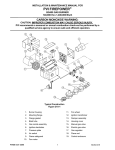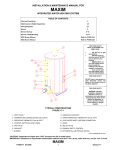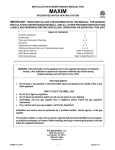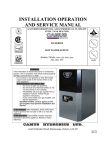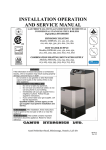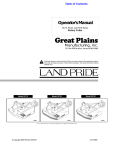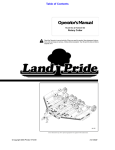Download PVI FIREPOWER GAS BURNER
Transcript
PVI FIREPOWER GAS BURNER TYPICAL CONSTRUCTION Figure 9-1 1. 2. 3. 4. 5. 6. 7. 8. 9. 10. 11. 12. 13. 14. Burner housing Air intake Oil pump opening plug Mounting flange Mounting flange gasket Blast tube screw Blast tube Nozzle assembly Nozzle mount bolt Air inlet cone Air screen Fan wheel Motor, 3450 rpm CWSE rotation Air nipple PV500-9 04-2000 15. 16. 17. 18. 19. 20. 21. 22. 23. 24. 25. 26. 27. 28. Air switch Door assembly * Flame sensing electrode Ignition electrode Ignition transformer On-off switch * 1/4” NPT pressure port plug Motor mounting plate * Motor relay or starter * Pressure plate Primary gas ports Secondary gas ports (gas spider) Gas regulator Gas valve (1) 29. 30. 31. 32. 33. 34. 35. 36. 37. 38. 39. 40. Orifice location * Electrode retaining bracket Burner cover Burner sight glass Air shutter Union Flame safeguard control Flame cone Manual gas valve Lifting eye bolt Power connector Manifold test port * On some models Section 9 POWER GAS BURNER START-UP (Refer to Figure 9-1 to identify burner parts) 1. Remove the enclosure panel cover on the water heater or boiler to expose the control circuit. Located on the back side of this cover is a wiring diagram of the unit. This diagram will show the controls used in our circuitry. 2. Visually check to be sure all components are intact and no damage has occurred during transit. 3. Check all connections within the control cabinet. A loose connection on a component could cause intermittent shutdowns. 4. Some burners will use direct spark ignition. They may use a single gas pressure regulator and gas valve or multiple valves and regulators. On a call for heat, the motor starts, the gas primary control is energized, and after a short delay (pre-purge), the gas valve(s) opens and ignition should occur. Some burners have longer pre-purge periods. On a call for heat, the control is energized which starts the motor and begins a purge sequence. On completion of the purge cycle, the gas valve(s) opens and ignition occurs. 5. Remove flame safeguard control from its base. Check connections in the control mounting base. Again, loose connections can cause nuisance shutdowns. Also check the time card or programmer, when applicable, for good connection. NOTE: Always secure gas lines and tag “Out of Service” before servicing burner nozzle or electrodes. 6. Pull the nozzle assembly to check the flame and ignition electrodes. This is done by first removing the burner cover, exposing the nozzle assembly. 7. The L-Series burner must be removed from the heater and the blast tube removed to access the electrodes. The electrodes may be accessible by removing the nozzle assembly on larger burners. Free the nozzle assembly from the gas train by breaking the unions on the gas lines. Some models will use an orifice that is installed in these unions. Retain for re-use. 8. 9. Next, remove the four bolts that hold the nozzle assembly to the burner housing. Once the nozzle assembly is free, pull it back slightly and remove the wires going to the flame and ignition rod. The easiest method of removing the nozzle assembly is to rotate it 90° upward and tilt slightly forward while working it towards you (see Figure 9-2). Be careful not to damage the electrodes. With the electrodes exposed, check them for the proper settings as called for in Figure 9-3. Also check for any hairline cracks in the insulators. Should replacement of burner electrodes be required, certain procedures must be followed. In all cases, removal of the electrodes is accomplished by loosening the electrode mounting bracket retaining screw. Draw the electrodes out of the nozzle assembly through the holes in the pressure plate. PV500-9 04-2000 (2) 10. Inspect the electrodes for cracked ceramics or loose retaining studs that hold the wire within the ceramic. Using supplied metric Allen wrench, loosen one or two pressure plate retaining screws so that the plate rotates freely on nozzle hub. Push plate towards the nozzle assembly gas spider to ensure it remains fully back and level. Do not re-tighten retaining screws at this time. Select the proper pressure plate hole in which to place each electrode and insert the electrode through the hole, retaining stud end first. Place electrodes in the electrode mounting bracket between the mount and the retaining bracket. 11. Tighten electrode mounting bracket screw slightly until electrode ceramics are seated firmly and completely in mounting bracket without gaps between ceramics and mounting bracket at the bearing faces. NOTE: Electrodes may have a high temperature, electrically insulating tape around them. The tape is designed to cushion the ceramic insulators in the mounting bracket, but is not absolutely necessary, and may be removed if it interferes with the positioning of the electrodes. 12. Ensure electrodes are loose enough to be rotated and that they will slide back and forth in the mounting bracket with firm finger pressure. 13. While ensuring the pressure plate is in the previously described position, measure and set electrodes according to Figure 9-3. After the gaps and settings are complete, fully tighten the electrode mounting bracket retaining screw. Do not overtighten or the insulation may crack. CAUTION: Electrodes may shift while tightening the screw due to rotation of the upper electrode mounting bracket. Holding down on this bracket while tightening the screw will stop this from happening. NOTE: The pressure plate may rotate on the nozzle hub as the electrodes seek their position during the tightening of the electrode mounting bracket retaining screw. This is desirable to prevent the electrodes from binding and not seating properly in the mounting bracket. The electrode ceramics will crack, causing ground faults in the circuit if this condition exists. 14. After complete mounting and positioning of the electrodes is accomplished, rotate the pressure plate so that no portion of the plate touches the electrode ceramics at the holes the electrodes pass through in the plate (ream holes slightly larger if needed to obtain Section 9 POWER GAS BURNER START-UP (Con’t) flame safeguard reset button. The burner should prepurge for not longer than thirty seconds. The TFM series control will have either an MT30-4, MT30-10 or MT12-5 time card. The “30 indicated a 30-second purge time and the “4”, “5” or “10” indicated a 4second, 5-second, or 10-second trial for ignition period, commonly called TFI. clearance). Ensure plate is seated firmly against the gas spider and tighten the plate retaining screws. Recheck electrode setting as to gap and position. 15. Replace nozzle assembly; be sure to connect the flame and spark rod wires before installing nozzle assembly fully into blast tube. Check to be sure connectors on the ends of the flame and spark rod wires have a good contact. Look for properly stripped wire ends. Be sure connectors are firmly attached to the flame and ignition rod ends. Insulating boots can give a false feeling of proper seating. BE CAREFUL NOT TO MOVE ELECTRODES. Be careful not to bump electrodes Check fan wheel for free rotation. When the blower motor starts, the air switch which proves air flow should close and terminal 6 will be powered. This starts the pre-purge timing sequence. After purging is complete, terminal 3 or 4 on the TFM control are energized. Terminal 3 energizes the pilot valve and terminal 4 energizes the ignition transformer. At this time, the pilot is established. The VDC reading on thermometer should read a steady 14-17 VDC for a TFM control. Each different control will have the required flame response signal stamped on it. This is the minimum for it to properly operate. If the pilot fails to light during the initial ignition period, it is probably due to air in the line. The control will lock out. Wait one minute and push the flame safeguard reset button to restart burner and begin the purge cycle again. 16. Reinstall orifices in unions (if required). Reinstall burner cover. 17. Connect a test meter to the control for reading the flame response signal. NOTE: Some controls read the flame signal in micro amps and some in volts DC. The TFM series control has two terminals marked for reading volts DC. The S89 control uses a micro amp signal for measuring flame strength. For this control, a meter must be hooked in series with the flame rod wire. Disconnect the leadwire at the S89 sensor terminal. Connect the positive lead of the meter to the quick-connect sensor terminal on the S89 and the negative lead to the free end of the sensor leadwire. 18. Be sure the tank is filled with water. Once the burner is reassembled, two devices to read pressure, preferable U-tube manometers, will be needed to read gas pressures. Connect one to read the inlet pressure of the burner. This is the pressure measured before all components in the gas train. The manometer must stay connected throughout the testing, as the inlet pressure must be monitored during the firing of the burner. Record static pressure. It must not exceed 14” W.C. for burners with inputs through 3,200,000 Btu/h. For inputs above 3,200,000 Btu/h, refer to the appliance date plate for the correct maximum inlet pressure Pressures above this could cause damage to the diaphragm in the gas valve or pressure regulator. 19. Burners with pilot: A. B. Connect the manometer to the manifold test port at the shutoff valve closest to the burner. Turn the main gas shutoff valve off. Set the air shutter as shown on the tag attached to the gas train, (see Figure 9-4 and 9-5). This may not be the exact setting you end with, but it is a good starting point. Turn the unit on using the rocker switch on the side of the control enclosure assembly and the toggle switch on the burner. If the operating control switches are closed, the burner should come on and pre-purge begin. Now, set the pilot pressure (measured downstream of gas valve) at the pressure shown on the tag attached to the gas train. Next, open the main gas valve slowly. Set manifold pressure at the pressure shown on the tag attached to the gas train. Do not screw the adjusting nut of the regulator in past the point where no further increase in manifold pressure is noted. Check the incoming pressure with the burner running. This is recorded as inlet flow pressure. Our standard flow pressure requirements are: a. b. c. C. 5” W.C. with 8” W.C. flow on burners with inputs through 1,600,000 Btu/h. 8” W.C. with 11” W.C. flow on burners with inputs from 2,000,000 Btu/h through 3,200,000 But/h. For inputs above 3,200,000 Btu/h, refer to the tag attached to the gas train for the correct inlet pressures. If the required manifold cannot be reached, check the inlet pressure. It should be a minimum of that shown above with the burner running on full input. It is important that the incoming pressure does not fall below these minimums or nuisance control lockouts could occur. NOTE: Where low gas pressure is a problem, special arrangements may have been made to fire the burner with reduced pressure. The appliance data decal will reflect this information. If nothing happens, check the control to be sure it is not in the tripped position and reset it by pushing PV500-9 04-2000 (3) Section 9 POWER GAS BURNER START-UP (Con’t) 20. Direct Spark Ignition – (DSI) Burners – No pilot: 1. Connect a manometer to the manifold test port. Set the air shutter as shown on the tag attached to the gas train. This may not be the exact setting you end up with, but it is a good starting point. Turn the unit on using the rocker switch on the side of the control enclosure assembly. The burner should come on and ignition occur. If the burner fails to ignite, there may have been air in the line. To reset the control, turn the switch off for 60 seconds (S89 controls only) and it should automatically reset or push the reset button on the control. Once the burner fires, set the manifold pressure at the valve shown on the tag attached to the gas train. There will a tap on the downstream side of the valve to measure pressure. The manifold pressure must be taken downstream of the gas valve. Check the incoming pressure with the burner running. This is recorded as flow pressure and must be a minimum of 8” W.C. 21. Make final settings of the air shutter by checking the flue gas analyzer. A. B. C. D. E. F. G. H. The readings need to be taken from a hole in the vent several inches above the heater vent connection, but before draft regulator. Insert draft gauge into the 1/4” test opening in the stack. Draft in stack should read -.02 to -.06 W.C. Adjust draft regulator, if installed. When water in the tank is above 120°F°, insert CO2 tester in 1/4” test opening and take CO2 reading in percentage. CO2 reading at this time will probably be below optimum. Gradually close the air shutter, taking CO2 reading at each adjustment of air shutter until optimum CO2 percentage (8-10%) is reached. If CO2 percentage decreases, open air shutter to last reading where the greatest reading was achieved. Insert CO tester in 1/4” test opening and take CO reading. CO should not exceed .03%. A reading greater then .03% indicates lack of air. Open air shutter slightly and take readings until CO is within proper range. Optimum reading is no CO. If air shutter has been changed during CO test, take a final CO2 reading. Insert stack temperature gauge in 1/4” test opening and read gross stack temperature. Temperature should be as shown in Table 9-1. If an excessively high gross stack temperature is recorded, check the flue tubes for baffles. All tubes should have at least one baffle for TURBOPOWER modules. Record the length of the baffles on TURBOPOWER models for future use. Make sure the air shutter is locked securely in place. PV500-9 04-2000 (4) SERIES STACK TEMPERATURES MAX. GROSS *MIN. NET STACK STACK PG (Vertical Tube) TP TPO TPGO 550°F 300°F 375°F 300°F TABLE 9-1 * Net temperature is the total stack temperature, less room temperature. 22. On burners with pilots, recheck pilot to make sure its operation has not deteriorated if adjustments are made to the air shutter. To do this, shut off the main valve, check the flame response signal by cycling the burner through several lightoffs. 23. Check each operating and limit control to be sure they function properly by lowering and raising the temperature setting on each control, causing the burner to cycle on and off. NOTE: During the initial firing of the burner, smoke that is not related to the burner will be emitted from the heater. This is normal during “burn in” and could possibly continue for several days. 24. Record the following information for future use: A. B. C. D. E. F. Air shutter position__________________________ Manifold gas pressure____________________"W.C. Stack draft_____________________________"W.C. CO2 reading______________________% (8%-10%) CO reading__________________% (less than .03%) Stack temperature: Gross_____________________________°F Less ambient_______________________°F Net_______________________________°F G. Thermal efficiency_________________________% Section 9 REMOVAL OF THE NOZZLE ASSEMBLY (EXCEPT “L” SERIES BURNERS) Figure 9-2 ELECTRODE POSITIONS “L,P,Q,R,S,T” SERIES BURNER Figure 9-3 PV500-9 04-2000 (5) Section 9 AIR ADJUSTMENT FIXED AIR BURNERS Loosen the locking screw and move the arm (B) along the scale (C) to the position wanted and tighten the screw. Check the air adjustment by making a flue gas analysis. Figure 9-4 AIR ADJUSTMENT VARIABLE AIR BURNERS Adjust first air shutter by loosening locking screw and move arm (B) along scale (C) to give best flame signal strength and most consistent light-off with pilot pressures set. Set second shutter linkage by installing linkage rod into ball joints of modulating motor and air damper shaft arm. With damper closed and modulating motor in full down position, set ball joints secured. Observe combustion reading through full range of modulation. Adjust as needed to obtain proper combustion efficiencies with carbon monoxide-free combustion. Make all adjustments with linkage in the low fire position. CAUTION: Do not allow the modulating motor to push the air damper past the full open or full closed position while making adjustments. Damage will occur. Record damper positions from indicator dials and hold linkage rod in ball joint with fingers as motor actuates to eliminate this risk. After correct damper movement is determined, tighten ball joint screws. Figure 9-5 BURNER MOTORS No routine service is necessary on the blower system other than cleaning the blower wheel or oiling the motor when necessary. Blowers using three-phase motors will run in either direction depending on the connection of the power supply. On new installations, motor replacement or power supply disturbance, the rotation must be checked. Corrections can be made by interchanging any 2 wires of the three-phase power supply. NOMOGRAPH FOR DETERMINING FLUE LOSSES FROM CO2 AND FLUE TEMPERATURE FOR NATURAL GAS (STEADY STATE EFFICIENCY CAN BE DETERMINED FROM THE FLUE LOSS) PV500-9 04-2000 (6) Section 9 Figure 9-6 NOTE: Nomograph is limited for use with Natural Gases with the following characteristics: Heating Value (gross) Btu/SCF - 970-1100; Specific Gravity - 0.57-0.70; Ultimate CO2 - 11.7-12.2. PV500-9 04-2000 (7) Section 9 NOMOGRAPH FOR DETERMINING FLUE LOSSES FROM CO2 AND FLUE TEMPERATURE FOR L.P. GAS (STEADY STATE EFFICIENCY CAN BE DETERMINED FROM THE FLUE LOSS) Figure 9-7 NOTE: Nomograph is limited for use with L.P. Gas with the following characteristics: Heating Value (gross) Btu/SCF – 2466-2542; Specific Gravity – 1.522-1.574; Ultimate CO2 – 13.73-13.82. PV500-9 04-2000 (8) Section 9 TROUBLESHOOTING SUGGESTIONS GAS BURNER 1. BURNERS FAILS TO START A. Defective On/Off or fuel transfer switch. Replace switch. B. Control circuit has an open control contact. Check limits, low water cutoff, proof of closure switch and others as applicable. C. Bad fuse or switch open on incoming power source. Correct as required. D. Motor overloads tripped. Reset and correct cause for trip out. E. Flame safeguard control safety switch tripped out. Reset and determine cause for apparent flame failure. F. Loose connections or faulty wiring. Tighten all terminal screws and consult wiring diagram furnished with the burner. G. Flame safeguard control starting circuit blocked due to flame relay being energized. Possible defective scanner or flame rod – replace. Possible defective amplifier – replace. Scanner actually sighting flame due to leaking fuel valve – correct unwanted flame cause. Defective flame safeguard control – replace. H. Defective blower motor. Repair or replace. 2. OCCASIONAL LOCKOUTS FOR NO APPARENT REASON A. Gas pilot ignition failure. Check to see that ignition is instant and that flame signal readings are stable and above minimum values. Use a manometer or 0 to 10" W.C. gas pressure gauge to make certain that pressure is as recommended. B. Loose or broken wires. Check all wire nut connections and tighten all terminal screw connections in panel and elsewhere as appropriate. C. With flame safeguard controls that incorporate the air flow switch in the non-recycling circuit, ensure that when main flame lights, the air flow switch is not so critically set as to allow occasional momentary opening of the air switch contacts. D. Occasional low voltage supply. Have local utility correct. Make certain that the burner control circuit transformer (if supplied) is correct for the voltage and power (VAC) being supplied. E. Occasional low gas supply pressure. Have local utility correct. 3. BURNER MOTOR RUNS, BUT PILOT DOES NOT LIGHT A. Gas supply to burner shut off – make sure all manual gas supply valves are open. Automatic high pressure valve at meter such as "Sentry" type tripped shut due to high gas pressure – reset valve and correct cause for trip out. B. Pilot solenoid valve not opening – listen and feel for valve actuation. Solenoid valve not being powered – check electrical circuitry. Replace coil or entire valve if coil is burned out. C. Defective gas pilot regulator – replace. D. Gas pressure too high or too low at pilot orifice (if supplied). Check orifice size in gas pilot assembly. Replace if incorrect. Readjust pressure as required. E. Defective ignition transformer – replace. Incorrect ignition electrode settings – readjust as required. F. Defective flame safeguard control or plug in purge timing card. Replace as required. G. Air flow switch not making circuit – check out electrically. Defective air flow switch – replace. Air switch negative pressure sensing tube out of position – reposition if necessary. 4. BURNER MOTOR RUNS & PILOT LIGHTS, BUT MAIN GAS FLAME IS NOT ESTABLISHED A. Main shut off or test cock closed. Check to make certain fully open. B. Pilot flame signal reading too low to pull in flame safeguard relay. Readjust as required. C. Defective automatic main or auxiliary gas shut off valves. Check electrical circuitry to valves. Replace valves or correct circuitry as required. D. Main diaphragm shut off valve opening too slowly. Adjust bleed on valve. E. Defective flame safeguard control or plug in amplifier. Check and replace as required. F. Butterfly valve set incorrectly on modulating burner. Readjust as required. G. Main gas pressure regulator atmospheric vent line obstructed. Correct. H. Defective main gas pressure regulator – replace. Misadjusted main gas pressure regulator – readjust to meet required operational values. PV500-9 04-2000 (9) Section 9 TROUBLESHOOTING SUGGESTIONS GAS BURNER (Con't) 5. CARBON MONOXIDE READINGS ON GAS FIRING A. Flame impingement on "cold" heat transfer surfaces caused by excessive firing rate. Reduce firing rate to correct input volume. B. Incorrect gas/air ratios. Readjust burner to correct CO2/O2 levels, eliminating all CO formation. 6. GAS HIGH FIRE INPUT CANNOT BE ACHIEVED A. Gas company pressure regulator or meter operating incorrectly, not allowing required gas pressure at burner train inlet. Have gas company correct. B. Gas cock upstream of train inlet not fully open. Check and correct. C. Gas line obstructed. Check and correct. D. Gas train main and/or leak test cocks not fully open. Check and correct. E. Gas supply line between gas company regulator and burner inlet too small. Check supply pressure at meter, determine pressure drop and increase line size as required, or raise supply pressure to compensate for small line. Do not raise pressure so high that under static (no flow) condition the pressure exceeds the maximum allowable pressure to the gas train components on the burner. F. Burner gas train components sized too small for supply pressure. Increase component size as appropriate or consult factory. G. Automatic gas valve not opening fully due to defective operation. Replace gas valve. H. Orifice (if supplied) too small. Replace with correct size. I. On modulating burner, butterfly valve not fully opened. Readjust. J. Defective main gas pressure regulator. Replace. K. Incorrect spring in main gas pressure regulator. Replace as required. L. Main gas pressure regulator vent line obstructed. Check and correct. M. Normally open vent valve (if supplied) not closing when automatic gas valves open. Check to see if valve is fully closed when automatic valves are open. Replace vent valve, if not closing fully. Additional troubleshooting information can be found in the Flame Safeguard Control bulletin supplied with the burner. PV500-9 04-2000 (10) Section 9










